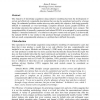Free Online Productivity Tools
i2Speak
i2Symbol
i2OCR
iTex2Img
iWeb2Print
iWeb2Shot
i2Type
iPdf2Split
iPdf2Merge
i2Bopomofo
i2Arabic
i2Style
i2Image
i2PDF
iLatex2Rtf
Sci2ools
KDD
1995
ACM
1995
ACM
Structured and Unstructured Induction with EDAGs
One objective of knowledge acquisition using inductive modeling has been the development of correct and effectively computable descriptions that can also be assimilated and used by a human being. On substantial problems neither trees nor rules satisfy this objective, both being generally difficult to understand as overt knowledge. Exception directed acyclic graphs (EDAGs) are knowledge structures that subsume trees and rules but can be substantially more compact. The comprehensibility of manually constructed and induced EDAGs is investigated by reconstructing Shapiro’s “structured induction” of a solution to the pawn versus rook end game. It is shown that the induced EDAG is very similar to that produced through consultation with experts, and that both are small, comprehensible solutions to a problem that is difficult for people.
| Added | 26 Aug 2010 |
| Updated | 26 Aug 2010 |
| Type | Conference |
| Year | 1995 |
| Where | KDD |
| Authors | Brian R. Gaines |
Comments (0)

